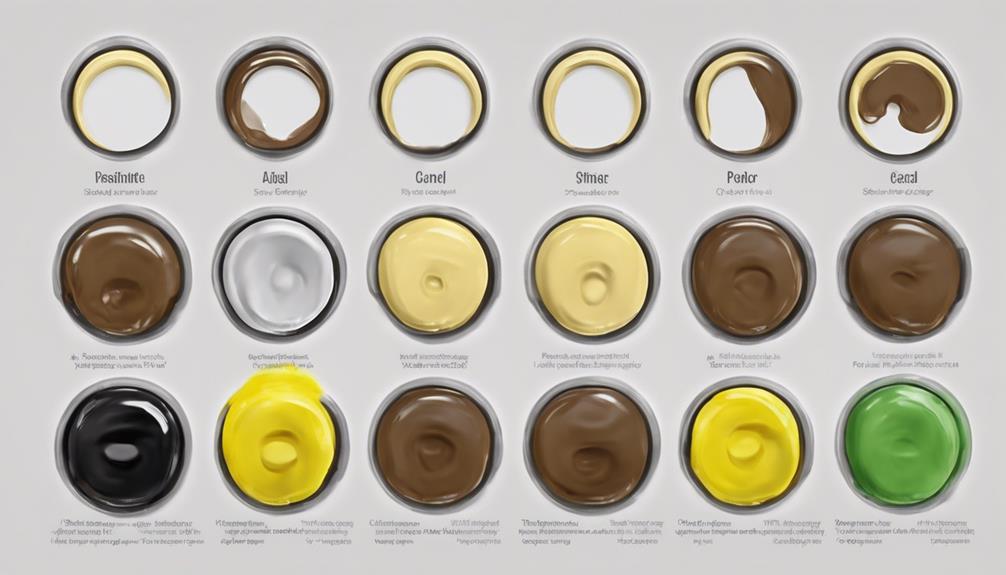In early pregnancy, changes in stool color can provide valuable clues about the shifts in digestion that come with the first trimester.
Have you ever wondered why that seemingly mundane aspect of your daily routine holds such significance during this transformative time?
Let's unravel the mysteries together and uncover the importance of monitoring poop color changes, shedding light on how our body communicates with us in unexpected ways.
Key Takeaways
- Early detection of digestive issues in first trimester through poop color monitoring.
- Differentiate between normal and abnormal stool colors for prompt intervention.
- Consult healthcare provider for red or significant brown color changes.
- Prioritize strategies like hydration and high-fiber diet for digestive health during pregnancy.
Importance of Monitoring Poop Color
Monitoring poop color during the first trimester of pregnancy is important for detecting potential digestive issues and health concerns. Changes in poop color can be indicators of underlying problems such as malabsorption, infections, or dietary changes that may affect the well-being of the mother and the developing baby.
By closely monitoring poop color, expecting mothers can gain valuable insights into their digestive health early on in pregnancy. It's essential to be vigilant about any unusual colors like black, red, or gray in stool as these may signal more serious conditions that require immediate medical evaluation.
Regularly observing poop color allows for timely identification of abnormalities, enabling early intervention if needed. With proper monitoring and attention to poop color changes, pregnant individuals can stay proactive in addressing any potential issues that could impact their health or the health of their baby.
Understanding Color Changes in Stool

Understanding the various color changes in stool is essential for pregnant individuals to maintain prime digestive health during the first trimester. Stool color changes in the first trimester can be influenced by a variety of factors, including hormonal fluctuations, dietary factors, and medications such as iron supplements and prenatal vitamins. Green poop, for example, may be a result of increased fiber intake or the use of prenatal vitamins. Monitoring these color changes is critical as it can help identify potential digestive issues or dietary sensitivities early on. By understanding what constitutes normal and abnormal stool colors during the first trimester, pregnant individuals can take proactive steps to address any arising concerns promptly. Below is a table outlining some common stool colors and their possible causes:
| Stool Color | Possible Causes |
|---|---|
| Green | Increased fiber intake, prenatal vitamins |
| Brown | Normal |
| Black | Iron supplements, dietary factors |
| Yellow | Digestive issues, dietary factors |
Common Causes of Color Variations
During the first trimester of pregnancy, various factors can lead to color variations in stool, which pregnant individuals should be aware of for best digestive health. Iron supplements are known to cause black or dark green stool color changes. Additionally, consuming foods high in fiber like leafy greens can turn stool green due to increased fiber intake.
Certain medications, such as antibiotics, can also temporarily alter stool color, sometimes appearing green. Digestive issues like constipation and hemorrhoids may contribute to changes in stool color as well.
Monitoring these stool color changes is important during the first trimester of pregnancy, as it can help identify potential health issues early on. Being mindful of these common causes can assist pregnant individuals in maintaining good digestive health and promptly addressing any concerns that may arise.
Red and Brown Stool in Pregnancy

Red and brown stool changes in pregnancy can be indicative of various underlying factors, necessitating careful observation and prompt medical evaluation. Here are some essential points to bear in mind:
- Red Stool: If you notice red stool during pregnancy, it's important to understand that it may signify the presence of blood. This blood could be due to conditions like hemorrhoids, fissures, or gastrointestinal bleeding, which require medical attention.
- Brown Stool: While brown stool is typically considered normal during pregnancy, factors such as diet, iron supplements, or medications can influence its color. Monitoring any changes in the shade of brown can help track potential issues.
- Healthcare Provider Consultation: Persistent red or significant changes in brown stool should prompt a visit to your healthcare provider. They can assess the situation and rule out any serious concerns, providing appropriate guidance and treatment.
- Contributing Factors: Hemorrhoids, constipation, and alterations in diet can also contribute to variations in red and brown stool color during pregnancy. Stay vigilant and seek professional advice when needed.
Tips for Digestive Health During Pregnancy
To maintain ultimate digestive health throughout pregnancy, it is essential to prioritize strategies that promote regularity and overall well-being. During the first trimester, changes in poop color can be indicative of various digestive issues such as constipation, diarrhea, or stool color variations. It is vital to stay hydrated, consume a high-fiber diet, and consult your healthcare provider if you notice any concerning changes in your stool. Monitoring your poop color regularly can help identify and address digestive issues early on in your pregnancy.
| Tips for Digestive Health During Pregnancy | ||
|---|---|---|
| Stay Hydrated | Eat a High-Fiber Diet | Consult Healthcare Provider |
| Monitor Stool Color Changes | Address Constipation | Manage Diarrhea |
Does Hunger in the First Trimester Affect Poop Color Changes?
During the first trimester of pregnancy, experiencing hunger is normal. However, whether hunger directly affects changes in poop color is unclear. It’s essential to focus on ways to manage hunger by having regular, nutritious meals. Keeping a balanced diet can contribute to overall digestive health and might indirectly affect the color of your stool. Consulting a healthcare professional for personalized advice is always recommended.
Conclusion
Just as the changing colors of a sunset signal the shift from day to night, monitoring poop color changes during the first trimester of pregnancy can provide valuable insights into digestive health.
By paying attention to these subtle indicators, we can better understand and address any potential issues that may arise.
Remember, like the shifting hues of the sky, changes in poop color can serve as a guide for maintaining overall well-being during this critical time.









